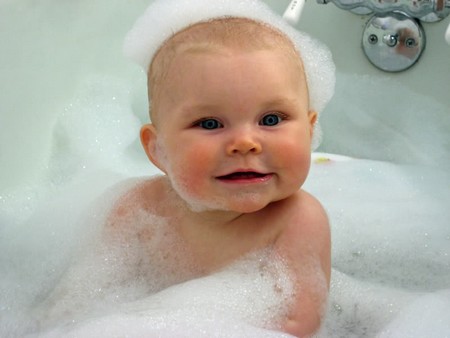You won’t be giving your baby a tub bath until the umbilical cord falls off (and the circumcision heals). Babies don’t get particularly dirty in the early months except for their bottoms, faces, and necks. A day without a bath isn’t a disgrace. In fact, until babies start to crawl, they need to be bathed only two or three times a week and shampooed once or twice a week. First babies probably get bathed more often simply because parents have more time.
If you and your baby feel the need to relax together, a long, warm bath may be just the right thing. You’ll soon learn which time of day works best for bathing. Some parents prefer to give baths shortly after feeding, even though it may increase the risk of baby spitting up.
Bath Equipment
- In the early weeks, you can make do with a plastic dish-pan. You really don’t need more than a few inches of warm water. Line the dish-pan with a small towel to prevent slipping.
- Bathe your newborn in an inflatable baby tub, or use a sculptured foam liner in a larger plastic tub.
- Bathe your baby in the bathroom or kitchen sink. Make sure the faucet is moved out of the way or padded in some way.
- Use a hand-held shower hose or kitchen sink sprayer. Your baby will enjoy the running water, and you can rinse his whole body easily. Spray gently to avoid stinging his skin.
- Wear cotton gloves or socks on your hands to improve your grip when holding and washing your baby. Or make bath mittens from old towels.
- Tie or pin a large bath towel around your neck, like a bib, to keep you dry and to provide a handy wrap-up for your baby. Or wear a waterproof apron.
- Use a hooded baby towel to keep your baby warm and cozy after a bath. Warm your baby’s towel near a radiator or heat vent.
- Drape a large, dry towel over your baby’s infant seat. Place your baby in the seat and wrap the towel around him immediately.
- Keep bath items handy by storing them in a plastic, handled toolbox near the tub.
- Remove potentially dangerous items from the tub or sink area. By four months, your baby will have the interest and ability to grab everything within reach.
Bathing Routines
- Keep the time babies are undressed to a minimum. When they’re older, they can better regulate their body temperature.
- Turn down the thermostat on your hot water heater to 120°F, to prevent your baby from being accidentally scalded. Run the cold water last so the faucet won’t be hot if your baby touches it.
- Use even mild baby soap sparingly on your baby’s skin. (Ivory is a strong soap; Dove and Neutrogena are better choices.)
- Bathe your baby by holding her facedown (face out of the water) in a frog-like position with your hand supporting her chest and tummy.
- Use only warm water to wash your baby’s face. Be careful to keep soapy water away from eyes.
- Set the plastic bottle of baby soap in the tub water so it will be warm when you’re ready for it.
- Remove cradle cap by gently scrubbing your baby’s scalp with a soft toothbrush or very soft hairbrush and a little baby oil or vegetable oil. Or soften the scales by applying baby oil or petroleum jelly at night and washing them off in the morning with a soapy washcloth. Make sure to check behind the ears for “crusties.”
- Put any powder you use into your hand first, away from your baby’s face, so the powder particles aren’t inhaled by your baby. For the same reason, don’t let an older baby play with an open powder container. Many doctors discourage the use of baby powder because the inhaled particles may irritate a baby’s lungs.
Categories
Advertisements
Recent Articles
 How to Understand Bed Sizes – A Small Guide
How to Understand Bed Sizes – A Small Guide How to Select Some Must Have Kitchen Accessories
How to Select Some Must Have Kitchen Accessories Best Way to Change a Car Tire
Best Way to Change a Car Tire Best Way to Write an Affirmation
Best Way to Write an Affirmation Best Way to Take Charge of Your Financial Life
Best Way to Take Charge of Your Financial Life Best Way to Survive a Party When You Don’t Know Anyone
Best Way to Survive a Party When You Don’t Know Anyone Best Way to Stop Self Sabotaging Yourself
Best Way to Stop Self Sabotaging Yourself Best Way to Start Journal Writing
Best Way to Start Journal Writing Best Way to Speak with a Powerful Voice
Best Way to Speak with a Powerful Voice Best Way to Simplify Your Life
Best Way to Simplify Your Life Best Way to Respond to a Put-Down
Best Way to Respond to a Put-Down Best Way to Reduce Acne Breakouts
Best Way to Reduce Acne Breakouts Best Way to Recover from Dining Disasters
Best Way to Recover from Dining Disasters Best Way to Quit Your Job Gracefully
Best Way to Quit Your Job Gracefully Best Way to Make Your Own Website
Best Way to Make Your Own Website



Leave a Reply